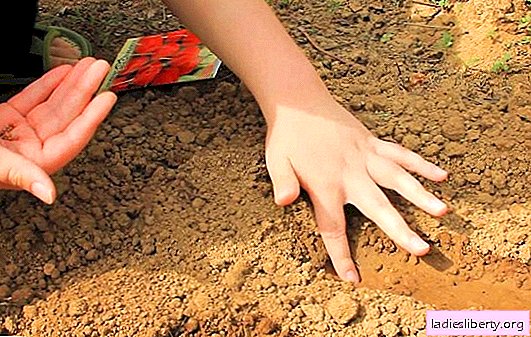
Growing radishes on a personal plot is one of the most effective of the ways to get early vitamins for many gardeners. With little time and labor, it’s easy to quickly get delicious root crops in early spring.
Growing a commodity radish will not be difficult for a novice gardener, but there are several points, not considering which normal root crops will not be able to grow.
For this culture, the timing of sowing seeds, care during the growing season and the control of the main pests are important.
Radish is one of the earliest root crops in our gardens, it contains many deficient vitamins in the spring, for this reason almost all gardeners allocate at least a little free space for it.
When to sow radishes
It should be noted that radishes are planted at a constant place at that time (with early sowing), when the first seedlings can break through at an ambient temperature of about 2 degrees, and for their proper development a stable temperature of not more than 15 degrees of heat is required.
If it is warmer on the street, then with a lack of sunlight in the spring, radish can go to the top of the leaves, and root crops will grow small and woody.
For this reason, seeds must be planted on time.

After the soil in the garden warms up and a constant temperature is maintained, seeds can be sown. Without shelters, the first crops begin in April, in the southern regions and in early spring, work can begin in March. In this case, you will have to water less often, since the soil has not yet dried out after the snow melts. If you are not sure that the weather will not damage the crops, then it is better to cover the beds with protective material (you can use agrofibre or black film). With early sowing, the first root crops can be harvested in May.
Pre-sowing preparation of the soil is an important stage in obtaining a worthy crop of this crop. The beds where you want to plant radish seeds should be well lit by the sun. The soil should be neutral or slightly acidic, loose and sufficiently moist. If the acidity of the soil is above the average, then before sowing it is necessary to add chalk or lime to it.
Sowing seeds
It is convenient to sow radishes where you are going to plant tomato seedlings; after harvesting the radishes, you can plant tomato bushes on the same beds. In areas with very heavy soil, beds need to be dug deep, scattering good humus on the surface before that.
Plants are planted in rows or in a nesting manner, with a space between rows of 10 cm, seeds sown in a row after 3-5 cm (the distance in a row depends on the size of the future root crop). A passage is made through each meter of the bed, for the convenience of radish care. When sowing by the nesting method, at least 5 cm of space is left on all sides of the plants.

Seeds are sown in wells or grooves pre-watered with hot water, after which they are covered with moist soil and lightly pressed so that the hole is no deeper than 1.5 cm. To trample the soil so that the soil sticks to the seeds as densely as possible, which will significantly reduce time necessary for the emergence of seedlings. Sometimes seeds are pre-glued with a paste on narrow paper strips (from newsprint or toilet paper), which will facilitate and accelerate the planting of radishes.
For sowing small seeds, they are sometimes mixed with fine sand, so you do not pour too many seeds into the groove. But it is better to plant each seed separately - so you do not have to subsequently thin out the crops and disturb the weak roots that are just developing.

To obtain the earliest root crops, a winter planting of radishes is used. Seeds are sown directly into dry grooves, then they are covered with soil, crushed with a plaque and mulched from above with horse peat, good compost or even dry soil, falling snow is poured on top of the bed. So the seeds at rest will wait out the winter period (at the same time they can be hardened), in spring, when the ground thaws, early seedlings will emerge that can drink the life-giving spring melt water.
Features of radish care
For this culture, it is important to ensure constant soil moisture in the bed, but excess moisture will also not lead to good, for this reason it is necessary to water the plants only when the soil is dried, to a sufficient depth and always in moderation, only to moisten the basal layer.
In this vegetable, the roots diverge a short distance from the bush, it is important that the moisture gets to the depth of the main root, in some varieties of radishes the root system can deepen to 30 cm. When buying seeds, carefully study the description of the variety.

After planting radishes, the beds are necessarily watered with warm water, through a watering can with a sprayer.
Warm water is very useful in the evening - so you keep warm in the area where seeds are located. The soil under the grown plants is moistened every 2-3 days, during the heat and strong wind it will be necessary to water more often, since the surface of the beds will dry quickly.
The radish has a short growing season, and during this period it should not be deprived of nutrients. On a poor site, plants can be fed with fertilizers at the same time as watering. Infusion of bird droppings, slurry or mineral fertilizers is mixed into irrigation water. But do not forget that an excess of fertilizers (this mainly applies to nitrogen compounds) will lead to the fact that the radish will increase its green mass or throw an arrow, as a result the root crop will cease to grow.
Note also that radish is prone to the accumulation of nitrates, for this reason it is advisable to use mineral compounds as little as possible, it is better to prepare an infusion of green mass of weed plants or wood ash.
These top dressings will serve simultaneously as a prophylactic against pests and fungal diseases. Ash will help scare away some types of aphids, snails and slugs.
To protect plants from cruciferous fleas, they are covered with plastic wrap during the revitalization of the pest. Of course, there are special chemical compounds designed to kill insects, but it is better to treat early root crops by natural means.
Timely detection and the right fight will stop the development of the cruciferous flea. For this, we can not prevent the growth of weeds on the site, remove residues from cultivated plants, often loosen the soil to break the crust that appears after watering. The use of mulch on the beds will help to ease the maintenance of radishes, for this they will do - ripened compost, horse peat, or you can use finely chopped grass to loosen the soil less often, inhibit the germination of weeds, and reduce the amount of watering required due to moisture , evaporate longer.











